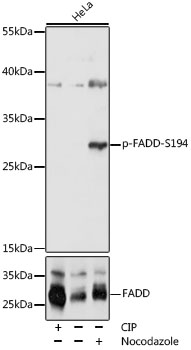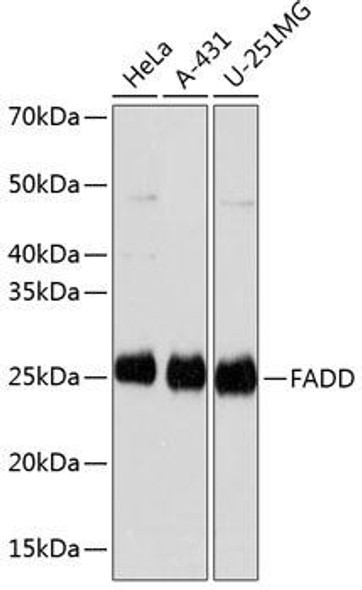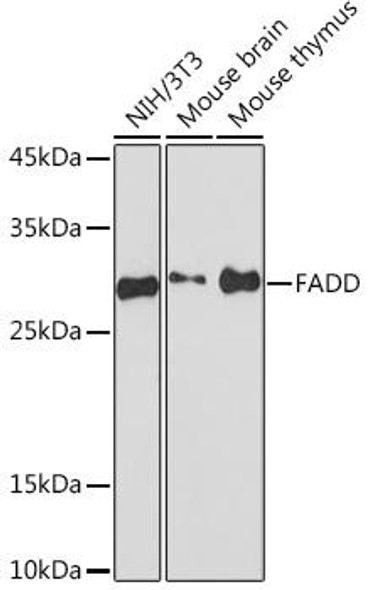Cell Death Antibodies 2
Anti-Phospho-FADD-S194 Antibody (CABP1054)
- SKU:
- CABP1054
- Product Type:
- Antibody
- Reactivity:
- Human
- Host Species:
- Rabbit
- Isotype:
- IgG
- Antibody Type:
- Polyclonal Antibody
- Research Area:
- Cell Death
Description
| Antibody Name: | Anti-Phospho-FADD-S194 Antibody |
| Antibody SKU: | CABP1054 |
| Antibody Size: | 20uL, 50uL, 100uL |
| Application: | WB |
| Reactivity: | Human |
| Host Species: | Rabbit |
| Immunogen: | A phospho synthetic peptide corresponding to residues surrounding S194 of human FADD. |
| Application: | WB |
| Recommended Dilution: | WB 1:500 - 1:2000 |
| Reactivity: | Human |
| Positive Samples: | HeLa |
| Immunogen: | A phospho synthetic peptide corresponding to residues surrounding S194 of human FADD. |
| Purification Method: | Affinity purification |
| Storage Buffer: | Store at -20°C. Avoid freeze / thaw cycles. Buffer: PBS with 0.02% sodium azide, 50% glycerol, pH7.3. |
| Isotype: | IgG |
| Sequence: | Email for sequence |
| Gene ID: | 8772 |
| Uniprot: | Q13158 |
| Cellular Location: | |
| Calculated MW: | 23kDa |
| Observed MW: | 28kDa |
| Synonyms: | GIG3, MORT1, FADD, FADD |
| Background: | The protein encoded by this gene is an adaptor molecule that interacts with various cell surface receptors and mediates cell apoptotic signals. Through its C-terminal death domain, this protein can be recruited by TNFRSF6/Fas-receptor, tumor necrosis factor receptor, TNFRSF25, and TNFSF10/TRAIL-receptor, and thus it participates in the death signaling initiated by these receptors. Interaction of this protein with the receptors unmasks the N-terminal effector domain of this protein, which allows it to recruit caspase-8, and thereby activate the cysteine protease cascade. Knockout studies in mice also suggest the importance of this protein in early T cell development. |
| UniProt Protein Function: | FADD: an adaptor molecule that mediates apoptosis. Recruited through its C-terminal death domain by Fas-receptor, tumor necrosis factor receptor, TNFRSF25, and TRAIL-receptor, participating in the death signaling initiated by these receptors. Interaction with the receptors unmasks the N-terminal effector domain of this protein, which recruits caspase-8, and thereby activates the cysteine protease cascade. Knockout studies in mice also suggest the importance of this protein in early T cell development. |
| UniProt Protein Details: | Protein type:Apoptosis; Adaptor/scaffold Chromosomal Location of Human Ortholog: 11q13.3 Cellular Component: neuron projection; CD95 death-inducing signaling complex; cytosol; lipid raft Molecular Function:identical protein binding; protein binding; protease binding; death receptor binding; protein complex binding; tumor necrosis factor receptor superfamily binding; tumor necrosis factor receptor binding Biological Process: viral reproduction; positive regulation of apoptosis; apoptosis; positive regulation of T cell mediated cytotoxicity; positive regulation of proteolysis; protein heterooligomerization; T cell differentiation in the thymus; toll-like receptor 3 signaling pathway; positive regulation of activated T cell proliferation; positive regulation of interleukin-8 production; T cell homeostasis; positive regulation of macrophage differentiation; toll-like receptor 4 signaling pathway; defense response to virus; positive regulation of adaptive immune response; spleen development; caspase activation; positive regulation of I-kappaB kinase/NF-kappaB cascade; thymus development; MyD88-independent toll-like receptor signaling pathway; positive regulation of tumor necrosis factor production; lymph node development; positive regulation of interferon-gamma production; induction of apoptosis via death domain receptors; toll-like receptor signaling pathway; innate immune response; positive regulation of transcription from RNA polymerase II promoter Disease: Infections, Recurrent, With Encephalopathy, Hepatic Dysfunction, And Cardiovascular Malformations |
| NCBI Summary: | The protein encoded by this gene is an adaptor molecule that interacts with various cell surface receptors and mediates cell apoptotic signals. Through its C-terminal death domain, this protein can be recruited by TNFRSF6/Fas-receptor, tumor necrosis factor receptor, TNFRSF25, and TNFSF10/TRAIL-receptor, and thus it participates in the death signaling initiated by these receptors. Interaction of this protein with the receptors unmasks the N-terminal effector domain of this protein, which allows it to recruit caspase-8, and thereby activate the cysteine protease cascade. Knockout studies in mice also suggest the importance of this protein in early T cell development. [provided by RefSeq, Jul 2008] |
| UniProt Code: | Q13158 |
| NCBI GenInfo Identifier: | 2498355 |
| NCBI Gene ID: | 8772 |
| NCBI Accession: | Q13158.1 |
| UniProt Secondary Accession: | Q13158,Q14866, Q6IBR4, |
| UniProt Related Accession: | Q13158 |
| Molecular Weight: | 208 |
| NCBI Full Name: | FAS-associated death domain protein |
| NCBI Synonym Full Names: | Fas (TNFRSF6)-associated via death domain |
| NCBI Official Symbol: | FADD |
| NCBI Official Synonym Symbols: | GIG3; MORT1 |
| NCBI Protein Information: | FAS-associated death domain protein; growth-inhibiting gene 3 protein; mediator of receptor induced toxicity; mediator of receptor-induced toxicity; Fas-associating protein with death domain; Fas-associating death domain-containing protein |
| UniProt Protein Name: | FAS-associated death domain protein |
| UniProt Synonym Protein Names: | FAS-associating death domain-containing protein; Growth-inhibiting gene 3 protein; Mediator of receptor induced toxicity; Protein FADD |
| Protein Family: | Fas-associated death domain protein |
| UniProt Gene Name: | FADD |
| UniProt Entry Name: | FADD_HUMAN |







